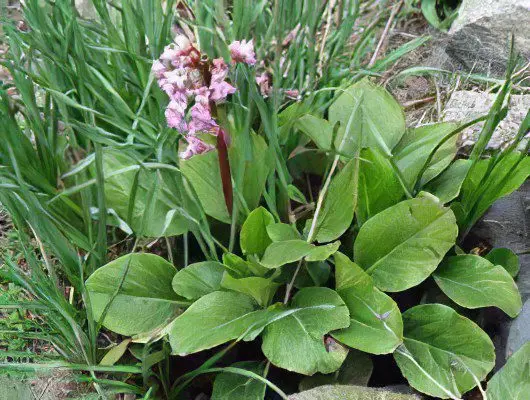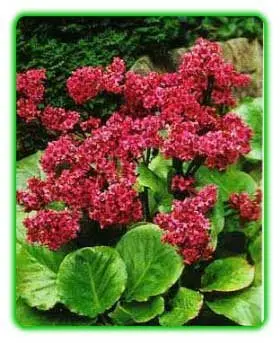Recipes for the use of the medicinal properties of badan thick-leaved
Wildflower buds

Badan thick-leaved is a perennial herbaceous plant. Badan grows mainly on wet slopes, common in forests, found in river valleys.
Its rhizome is powerful and branched. The leaves are leathery, shiny, have dotted glands on the underside of the leaf. The flowers are red, bell-shaped, collected in a dense panicle. Badan grows very slowly. Numerous, rather large in size and rounded, very thick-skinned leaves gradually grow from the rhizome. In autumn, the leaves take on a fiery red hue. They are also kept in winter. The rhizome of bergenia is dark brown above, and at the break it is light pink in color, darkens very quickly in the fresh air. The fruit of the plant is a box with two blades. There are many seeds, they are slightly wrinkled. Badan blooms in June and July. During flowering, the shoot of the plant stretches into an arrow, reaching a height of up to 60 cm. It is suitable for eating after thorough soaking.
Parts of the plant used to treat
Medicinal raw materials for bergenia are both rhizomes and the aerial part of the plant: these are leaves, flowers and seeds.
They are collected in the usual way, dried in dryers. The temperature should not exceed 60°C.
The chemical composition of bergenia thick-leaved
Both the ground parts of the plant and the rhizomes contain tannins, flavonoids, a lot of manganese, iron, copper, some vitamins and phytoncides, and arbutin. The roots also contain polyphenols, a large amount of tannins, resins, starch. The whole plant has strong phytoncidal activity.
The use of badan thick-leaved in folk medicine
The medicinal properties of bergenia are widely used not only in medicine, but also in cosmetology. The plant is used to prepare lotions that quickly treat oily seborrhea of the face and hair, seborrheic dermatitis, sweating and acne. It is effective on skin with visible pores.
Badan is also used in cooking. Its rhizomes, soaked in water, are rich enough in starch, so they are justifiably eaten in the form of soups and as a side dish for meat.
The roots are used for enterocolitis, in gynecology for the treatment of erosions. The plant is promising for the treatment of malignant tumors, as it has shown a high percentage of anti-stress activity.
It has been experimentally established that preparations based on bergenia have a strong astringent, anti-inflammatory and hemostatic effect. They can strengthen the walls of capillaries. They also have a vasoconstrictive effect. Other studies have shown that extracts and tincture of bergenia effectively increase heart rate and lower blood pressure. The plant has antimicrobial and diuretic properties.
In folk medicine, bergenia is used as a substitute for bearberry. The plant is especially valued for its antimicrobial, hemostatic and wound healing properties. Effectively used in the treatment of diseases of the lungs, gastrointestinal tract. It is used in the treatment of dermatoses.
In folk medicine, rhizomes were used for lung disease, for the treatment of acute respiratory infections, influenza, whooping cough.
The plant has gained popularity in the treatment of headaches, articular rheumatism, gastritis and fever.
Even in medicine, infusions of bergenia are used for hemorrhoids. The plant effectively treats uterine fibroids, uterine bleeding. Diseases of the oral cavity, larynx, bleeding gums are also treated with infusion of bergenia.
Recipes for the use of badan thick-leaved

In order to prepare the infusion, you need to take about 20 grams of leaves and flowers of the plant, then pour a glass of hot water. Infuse the composition in a water bath for up to 15 minutes, then cool. This will take you approximately 45 minutes. You can take two tablespoons several times a day.
To prepare a decoction, take 15 grams of roots, pour a glass of hot water. Further according to the scheme: insist on a water bath for half an hour and cool for 15 minutes. It is recommended to take 2 tablespoons, three times a day after meals. With the same decoction, you can gargle, do douching and lotions.
Mix one spoonful of bergenia leaves and elecampane and two tablespoons of St. John’s wort. One spoonful of this collection pour 200 ml of hot water, boil over low heat for about twenty minutes, and then leave for another hour. You need to take the remedy in a quarter cup twice a day in hot form, you can add sea buckthorn oil to the infusion. In this way, a severe runny nose can be quickly cured.
If you add a couple of tablespoons of bergenia rhizomes to a glass of boiling water, then cool and strain, you will get an effective infusion for rinsing with periodontal disease and stomatitis, as well as for douching.
You can also prepare an extract of bergenia. To do this, pour a couple of tablespoons of dried and crushed plant roots with a glass of hot water and boil over low heat in a sealed container until half of the liquid has evaporated. Take this extract should be 27 drops several times a day.
A decoction of bergenia in folk medicine can be used to take sitz baths, which are prescribed in the treatment of hemorrhoids. The temperature of the baths should not exceed 38 ° C, and the duration should not exceed 20 minutes. The number of baths is no more than 15.
You can also make medicinal tea. To do this, you need to add a black leaf of bergenia to the mixture of herbs from which you make tea. Where to get it? The old leaves of the plant, which are located below, periodically die off, then they dry out and turn black. These are the black leaves you need. It is better to cut them off from the badan in the spring. It is from such old, at first glance unsuitable leaves that have lain all winter under the snow, that the famous Altai tea is prepared, which is very tasty. It has healing properties precisely because of these leaves. To make this tea, simply dry the leaves and use them within two years of harvesting. Why drink this tea? It perfectly eliminates physical and moral overwork, has very strong tonic properties for the body.
Badan is brewed a little longer than black tea. This is because its leaves are much thicker than tea leaves. It is possible to improve the quality of taste and the effective transition of active substances into the infusion, bring the composition with leaves to a boil, but do not boil, that is, do everything as when brewing coffee.
The use of badan thick-leaved in other areas
The plant is used, namely the tincture and extract from the rhizomes, and in veterinary medicine. Badan is valued for its astringent and anti-inflammatory properties. The plant is in the first row of world tanning agents. For landscaping areas, the plant is used as an ornamental. It looks beautiful in massifs in front of shrubs, in front of trees and in rocky gardens.
Contraindications for the use of badan thick-leaved
If you take a decoction of bergenia roots for a long time, you can provoke constipation. You can not drink tincture and decoction of badan to patients suffering from increased blood clotting.
A decoction of the roots of this plant often lowers blood pressure, so it is worth monitoring its level separately. For this purpose, you can take decoctions of herbs that increase blood pressure. But, on the other hand, badan increases the heart rate, so people who have tachycardia are not recommended to take it in large quantities.









